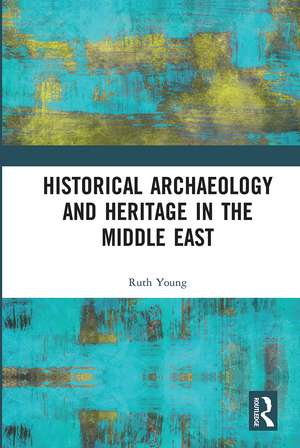Historical Archaeology and Heritage in the Middle East
Autor Ruth Youngen Limba Engleză Paperback – 30 sep 2020
Historical Archaeology and Heritage in the Middle East explores these everyday, rural communities in Iran and Oman in the 19th and 20th centuries, through a combination of building analysis, excavation, artefact analysis and ethnographic interviews. Drawing on the results of original field projects, the book considers new ways of exploring traditional lifeways, giving voice to hitherto largely ignored sections of the population, and offers new and different ways of thinking about how these people lived and what shaped their lives and the impact of major political and social changes on them. Place, memory and belonging are considered through the lens of material culture within these villages.
The first of its kind, the book brings together methodologies, research questions, and themes that have never been used or addressed in the Middle East. Helping to establish historical archaeology in the Middle East and providing new ways in which the memorable, quotidian past can be exploited for its social and economic value in contemporary community and heritage developments, it is an ideal resource for students, scholars and practitioners of historical archaeology and heritage of and in the Middle East.
| Toate formatele și edițiile | Preț | Express |
|---|---|---|
| Paperback (1) | 272.83 lei 6-8 săpt. | |
| Taylor & Francis – 30 sep 2020 | 272.83 lei 6-8 săpt. | |
| Hardback (1) | 1005.94 lei 6-8 săpt. | |
| Taylor & Francis – 31 ian 2019 | 1005.94 lei 6-8 săpt. |
Preț: 272.83 lei
Preț vechi: 326.67 lei
-16% Nou
Puncte Express: 409
Preț estimativ în valută:
52.21€ • 54.31$ • 43.10£
52.21€ • 54.31$ • 43.10£
Carte tipărită la comandă
Livrare economică 14-28 aprilie
Preluare comenzi: 021 569.72.76
Specificații
ISBN-13: 9780367662318
ISBN-10: 0367662310
Pagini: 256
Dimensiuni: 156 x 234 x 20 mm
Greutate: 0.47 kg
Ediția:1
Editura: Taylor & Francis
Colecția Routledge
Locul publicării:Oxford, United Kingdom
ISBN-10: 0367662310
Pagini: 256
Dimensiuni: 156 x 234 x 20 mm
Greutate: 0.47 kg
Ediția:1
Editura: Taylor & Francis
Colecția Routledge
Locul publicării:Oxford, United Kingdom
Cuprins
List of Figures
Acknowledgements
Notes on the Identification of Interviewees
1 Introduction
The aims of this book
Key concepts in this book: place, memory, belonging
Heritage
The case studies
The Iran project: Landlord Villages of the Tehran Plain
Landlord villages of Iran
Post revolution villages
The Oman project: Bat Oasis Heritage Project
Oman villages of the interior
Housing changes in Oman
Conclusion
2 Recent histories of Iran and Oman
An outline of recent Iranian History
An outline of recent Omani history
Nation building, heritage, and place
Iran: nation building by the Pahlavis
Oman: nation building by Sultan Qaboos
Conclusion
3 An archaeology of place and memory
Archaeology is a way of understanding how people make place
The village plans
Place and power
Giving meaning to place
Place and religion
Public places
Place and memory
Post abandonment
Landlord villages
Bat Oasis
Conclusion
4 Memory, place and belonging
Place, archaeology and memory
Place and belonging under attack
Mudbrick and memory in Oman
Mudbrick and memory in Iran
Kazemabad and Hosseinabad Sanghar memories
Gach Agach memories
Discussion and conclusion
5 Heritage in the Middle East
Heritage
UNESCO World Heritage in relation to the Middle East
Why is the Bat prehistoric archaeological landscape a WH site and not the Bat Oasis?
Heritage in the Middle East
National heritage in Oman
National heritage in Iran
Quotidian and fragmented heritage
Conclusion
6 Historical archaeology and heritage in the Middle East
Barriers to historical archaeologySo how should we go about setting up ‘good’ heritage and archaeology projects?
Community involvement
Conclusion
Bibliography
Index
Acknowledgements
Notes on the Identification of Interviewees
1 Introduction
The aims of this book
Key concepts in this book: place, memory, belonging
Heritage
The case studies
The Iran project: Landlord Villages of the Tehran Plain
Landlord villages of Iran
Post revolution villages
The Oman project: Bat Oasis Heritage Project
Oman villages of the interior
Housing changes in Oman
Conclusion
2 Recent histories of Iran and Oman
An outline of recent Iranian History
An outline of recent Omani history
Nation building, heritage, and place
Iran: nation building by the Pahlavis
Oman: nation building by Sultan Qaboos
Conclusion
3 An archaeology of place and memory
Archaeology is a way of understanding how people make place
The village plans
Place and power
Giving meaning to place
Place and religion
Public places
Place and memory
Post abandonment
Landlord villages
Bat Oasis
Conclusion
4 Memory, place and belonging
Place, archaeology and memory
Place and belonging under attack
Mudbrick and memory in Oman
Mudbrick and memory in Iran
Kazemabad and Hosseinabad Sanghar memories
Gach Agach memories
Discussion and conclusion
5 Heritage in the Middle East
Heritage
UNESCO World Heritage in relation to the Middle East
Why is the Bat prehistoric archaeological landscape a WH site and not the Bat Oasis?
Heritage in the Middle East
National heritage in Oman
National heritage in Iran
Quotidian and fragmented heritage
Conclusion
6 Historical archaeology and heritage in the Middle East
Barriers to historical archaeologySo how should we go about setting up ‘good’ heritage and archaeology projects?
Community involvement
Conclusion
Bibliography
Index
Notă biografică
Ruth Young is a Reader in Archaeology at the University of Leicester, UK. She is interested in the historical archaeology and heritage of the Middle East and South Asia and has directed and co-directed excavations and fieldwork in Iran, Lebanon, Oman, and Pakistan. Her recent publications include Post-Conflict Archaeology and Cultural Heritage (2017, Routledge), and The Archaeology of South Asia (2105).
Descriere
Historical Archaeology and Heritage in the Middle East explores everyday, rural communities in Iran and Oman in the 19th and 20th centuries, through a combination of building analysis, excavation, artefact analysis and ethnographic interviews.
